
Pillars of Eternity II: Deadfire is the game Obsidian has always wanted to make
When Pillars of Eternity II: Deadfire was first announced via a fig campaign earlier this year, it was able to quickly match the overwhelmingly positive response to the initial game's Kickstarter campaign: Deadfire was able to hit 4.4 million dollars in funding on a goal of just over $1 million. Obsidian has worked on a number of successful sequels: Knights of the Old Republic 2, Neverwinter Nights 2, and Fallout: New Vegas to name a few. But with Deadfire, this is the studio's first chance to explore new areas and tell new stories in a world of their own creation. And they couldn't be more excited.
Deadfire finds the Watcher from the previous game in a new region: the Deadfire Archipelago. They head into the city of Tikawara and come across a village chief with access to a map of nearby ancient ruins. This kickstarts the next adventure in a region that is not only constantly under unrest by warring factions, but also in the middle of turbulent weather that prevents easy travel, alongside storms that never end. The Watcher will find themselves in charge of a putting together a crew and a ship while unraveling the mysteries of the region.
I had a chance to chat with Executive Producer Adam Brennecke and Design Lead Josh Sawyer to discuss Pillars of Eternity, Obsidian as an independent developer, and RPGs old and new.
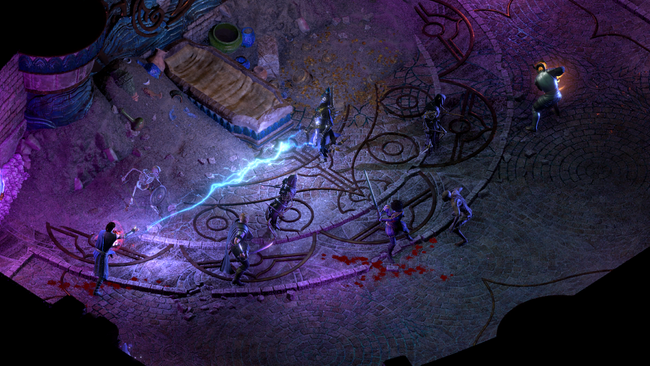
With the initial success of Pillars of Eternity out of the gate, Obsidian was immediately aware that they had a property that they could revisit for years to come. "We kind of knew right away that it would be a world that we could dive back into to tell new stories," Adam recalled. The developers had left several regions of the world unexplored alongside a plethora of untapped lore that they hadn't had a chance to touch on in the initial game. "We left teases for the Deadfire Archipelago in a few questlines in the original Pillars, but it was something that we hadn't yet fleshed out or given the player a chance to explore yet," he added.
On how the world of Pillars is different from working on an established IP, Josh remarked, "To be honest, telling a good story or designing meaningful quests with choice and consequence can happen independently of the world it's in: it could be Star Wars or Fallout or Pillars." But here, Obsidian has a world introduced in Pillars that wasn't fully realized, one that they could expand on, and a sequel seemed the perfect opportunity to do just that.
While the world could be expanded in any direction the developers wanted, a sense of continuity was also paramount when designing Deadfire. "We wanted the choices made in the original Pillars to carry over into Deadfire, so it made the most sense to continue the story of the Watcher from the original game," Adam asserted. While the Watcher will be able to pick a new class and abilities and can effectively be a new character, gameplay-wise, Obsidian wanted the choices that resulted from the Watcher's quest in the Dyrwood and the Watcher themself to be linked together; it wouldn't make sense for some other character to inherit those decisions.
"We've always wanted to create experiences where players can take on any role they want. They can be a dwarf of any gender that worships whatever god. They can be a barbarian with few morals or a devout soldier," Josh added. This was once design area where the developers felt it was necessary to prioritize cross-game continuity: "We have the opportunity to expand on the world we've created with Pillars, but it's important that Deadfire allow people to continue the story of their own personal Watcher that they've already spent hours defining in Pillars of Eternity."
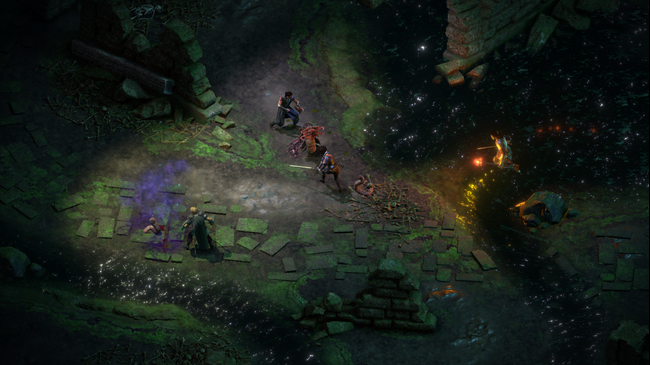
This doesn't mean that playing the first title is entirely necessary. New players will have two available options to set their world state as they enter Deadfire: they will be able to completely randomize the past choices and make the decision to deal with the repercussions, whatever they may be, or they will be able to fine tune these sorts of decisions like they would with another other aspect of character creation. "We definitely want players to be able to specify their decisions too when it comes to what sort of consequences are carried over," Josh explained. It wouldn't mesh with Obsidian's core philosophies to not give players that choice. He added, "You can look at Bioware's Dragon Age Keep to get an idea of what level of precision we want new players to have access to."
There's a lot to be excited about with Deadfire: as mentioned, it's Obsidian's first chance to really make a sequel. Mechanically, there's a new subclass system that further increases the level of specialization that any one player can have. "We have over 50 class/sub-class combinations so there is a lot of flexibility in how player characters can be built." Josh recalled the unsurprisingly difficult task of coming up with a complete list of unique profession names for each combination. Adam added, "With Deadfire we finally have a chance to build on from one of our own IPs, in whatever manner we please." Pillars is something that is uniquely Obsidian and the creators are primed to take full advantage. "It's really cool to expand from what we started out with in the initial release, only basically everything is bigger and better."
Josh took the opportunity to add to that train of thought about the other flexibility Obsidian has with the Pillars IP. "I'm actually working on a pen-and-paper game built around the Pillars mythos, and we have a card game that we kickstarted as well. We can do a lot of creative things with Pillars, which is afforded to us by owning the IP ourselves."
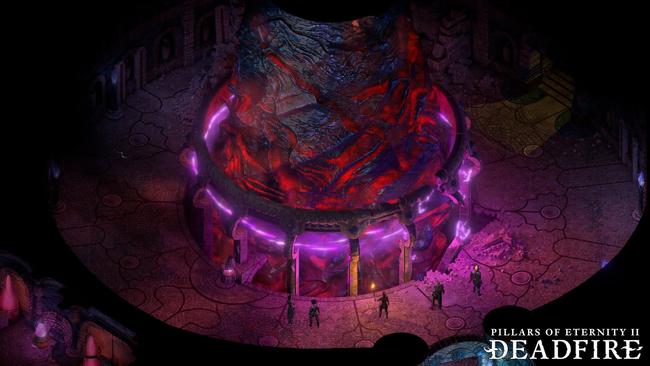
As to how Deadfire improves on the initial game, Adam and Josh each had a very long list: "We have a large world that gives the player the freedom to go anywhere. We have inhabitants of the world with lives of their own and they own unique schedules," Josh described. The phrasing "open world" was used, but it was clear that this was meant specifically in terms of scope of the game - the map transitions are not completely seamless. There is a great deal of variability in how the game unfolds depending on the route the player decides to take. For instance, certain questlines can unravel differently depending on when and where characters and environments are approached, depending on weather, faction reputation, and potentially other factors.
Adam noted the importance of the learning process of the original release as it related to the various improvements imminent in Deadfire: "All the tweaks and adjustments that we've made within our engine and within our design for the original game has come to a head with Deadfire: we have a completely new UI, a new spell rendering system, dynamic weather and quests, a really cool customization gameplay mechanic with the boats used by the players crew: I think it improves on the first game in every way."
One more lukewarm aspect of the original game was the Stronghold system: put in place in the first Pillars as one of the original stretch goals, but the way it was implemented left a bit little to be desired. Josh more or less agreed: "You would go back to change companions and undertake a few small tasks, but it never really felt as important as it should have." So of course, Obsidian decided to take the chance to right the ship, literally. "With the ship system in place in Deadfire, we've found a way to incorporate a lot of the same ideas into a component of the game that is far more important: I mean you'll be using your ship whenever you travel! So obviously the mechanics tied around that system will be far more important and significant."
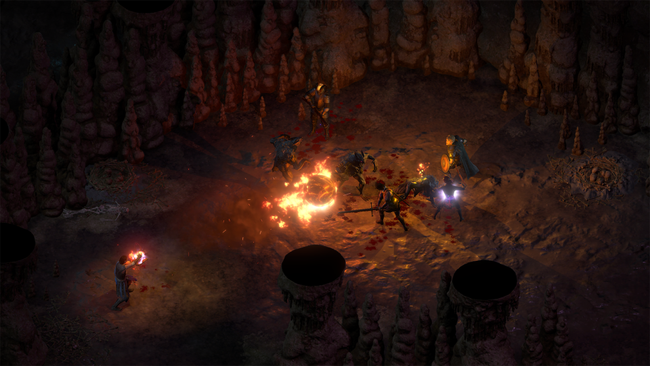
Both Adam and Josh are long time veterans of Obsidian and they've had the unique opportunity to work on a lot of various IPs from existing franchises. Josh, in particular, made it clear that he doesn't take the unique circumstance for granted. "One of my life-long dreams was to be able to work on a Fallout game, ever since I was first brought on by Black Isle Studios. So when I finally got the chance with Fallout: New Vegas, I was really excited". Obviously from that point it was a different sort of game compared to what Black Isle had developed prior, but it was still a personal highlight. Even after New Vegas launched, Josh developed his own personal mod for the game after it was released!
But for others, nothing is better than the present for Obsidian. "As of right now, Pillars as a whole is my favorite project that we've ever put together," Adam exclaimed. From the success of the initial Kickstarter campaign to what they are doing now with Deadfire, the passion has seemingly never been higher.
Since the release of Pillars of Eternity, two heavy hitters in the AAA western RPG spaced landed in Witcher 3: Wild Hunt, and Bethesda's Fallout 4. When asked if they take the reception of these games into account when developing Deadfire, Adam made it clear that Obsidian is not really targeting the same sorts of goals as those two behemoths. "I really enjoyed the continuation of the narrative between the three Witcher titles; Geralt's story told across three games is a remarkable achievement, but that sort of bespoke characterization is just not quite the same thing as we're looking to create with our games." Obsidian wants to give players the ability to create whatever sort of protagonist they want and give them the tools to do so with their titles.
Josh added that the gameplay style of Pillars is linked to this goal: "Obviously, games like Pillars of Eternity are developed on a smaller scale, so we really want to focus on making a dense game that people can spend hundreds of hours in." He went by invoking the common heuristic about evaluating the level of player-choice via the metric of a game's number of immortal quest-critical NPCs. "Having that sort of limitation in place is something we want to avoid if at all possible."
Having emergent, personal stories within a well-crafted narrative is something Obsidian believes is not only possible, but it is something that they feel they've been doing well for years now. "One of my favorite stories is that of a certain Fallout: New Vegas playthrough", Adam recounted. "It was about a player that decided to role-play as a sort of Two-Face inspired character. He used a sort of coin-flip challenge, where he would use random chance to determine if any given npc character would die or not." That sort of thing isn't possible in a game like The Witcher. Obsidian feels that games should have that be possible.
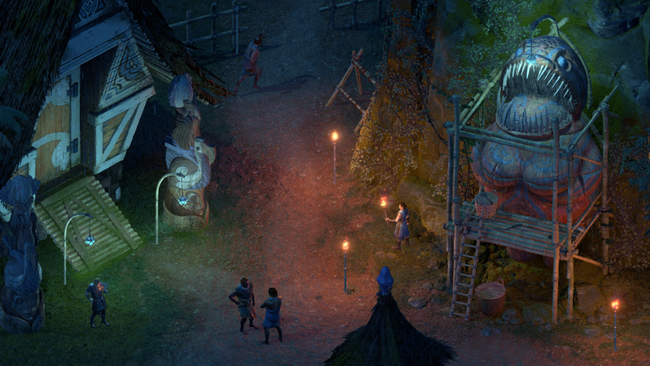
Pillars of Eternity II: Deadfire is slated to release in Early 2018 for PC.